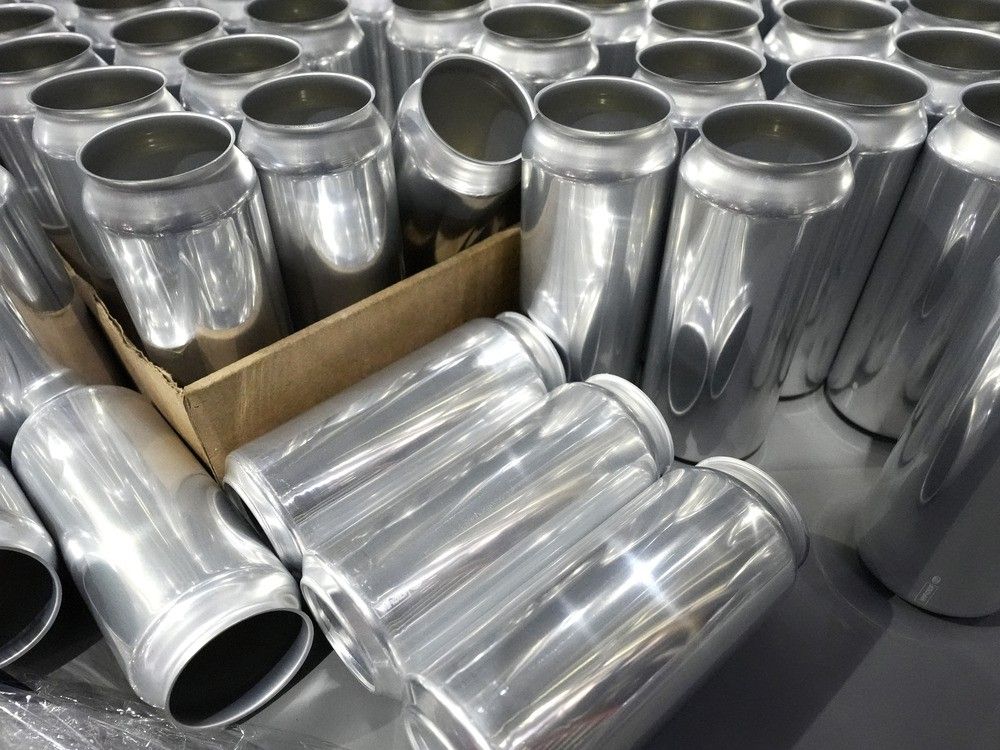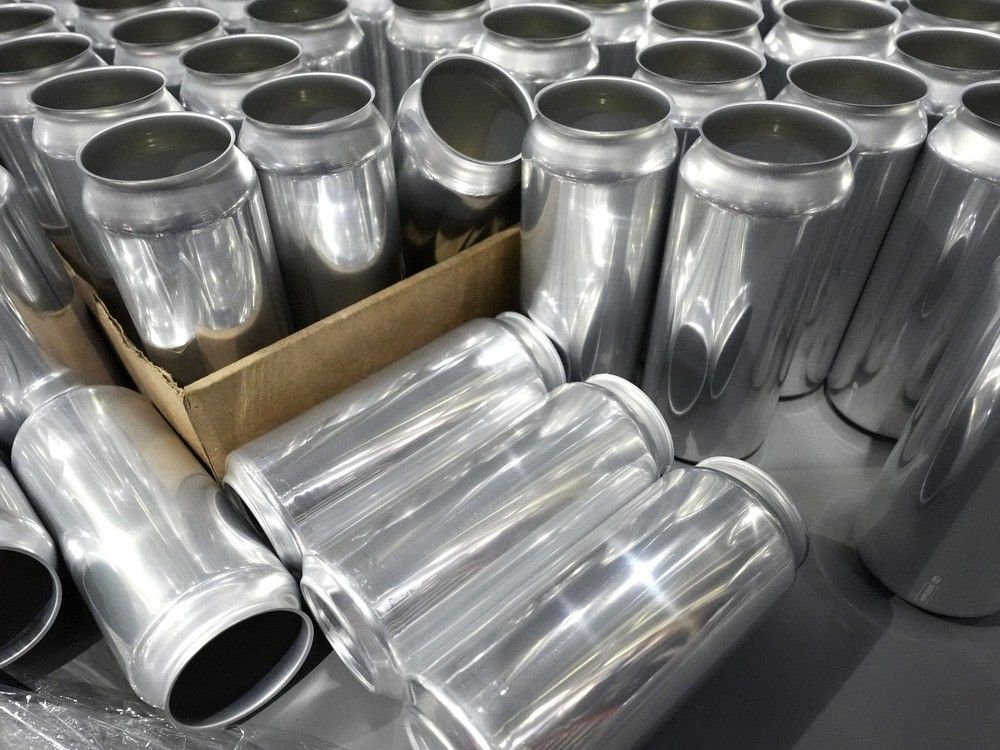
WASHINGTON, D.C. — Patrons huddle around the 30-foot-long wooden bar at Spiteful Brewing on Chicago’s Northside, enjoying drinks, televised sports, and games ranging from darts to Dungeons & Dragons.
“It’s a corner tavern without the booze,” says co-founder Jason Klein, noting they only serve beer they brew on-site, not liquor. What customers don’t see is the storeroom, where Klein is engaged in another game: playing Tetris with supplies.
U.S. President Donald Trump’s aluminum tariffs have forced U.S. breweries to consider stockpiling cans as a hedge against rising costs, but for small brewers like Klein, space is limited.
“It’s like a puzzle back there for us. We’ve had to sacrifice on things like grain so we could hook up on cans,” he says. But Klein is facing more than just logistical challenges.
Trump imposed 25 per cent tariffs on steel and aluminum in February, citing the need to promote domestic manufacturing and protect national security. He then doubled them to 50 per cent in June, and small brewers are feeling the squeeze.
Trade talks are underway, with Canada looking for deals to reduce or avoid Trump’s tariffs. Both sides aim to conclude a deal by July 21. If no deal is reached, the tariffs will remain. Meanwhile, higher costs threaten the thin margins and production capacity of smaller U.S. brewers, while trade tensions are limiting export opportunities for the larger ones, particularly in their biggest market, Canada.
An industry on the edge
American craft brewing took off in the 2010s but has since faced challenges, including oversaturation, COVID, and inflation. “Everything’s gone up,” Klein says. “Grain has gone up. Hops have gone up. Storage has gone up.” With input prices rising, brewers feel pressure to raise prices but worry about going too far.
“At some point, you’re not going to pay $14, $15, $16 for a six pack,” Klein says, noting that sales have already slipped.
The whole industry is grappling with this trend. U.S. craft beer production peaked in 2019 and has since declined, according to the Brewers Association. The U.S. craft brewing industry saw a 3.9 per cent drop in barrel production between 2023 and 2024 and a slight decline in its overall U.S. beer market share, dropping to 13.3 per cent. Its retail value grew by 3 per cent to $28.9 billion, but that was largely due to price hikes and strong taproom sales.
Now, the industry is facing even higher production costs related to the price of aluminum cans.
Aluminum cans are the go-to for US breweries because they are light, easy to ship, and more environmentally friendly, as aluminum is recyclable. As of January, cans accounted for 75 per cent of the craft beer market share, according to Beer Insights, so there was plenty of panic when the tariffs were introduced.
Much of the aluminum used for canning in the U.S. comes from domestically recycled products, while just 30 per cent is sourced from raw aluminum, largely from Canada. It’s only the raw imports that are directly impacted by tariffs, which means the feared price spikes have been minimal, thus far.
But the price of aluminum generally is based on the London Metal Exchange (LME) and the Midwest Premium indices, and while the LME hasn’t changed much this year, the Midwest Premium has soared, hitting a record 60 cents per pound in early June — a whopping 161 per cent rise since January. Distributors peg their rates to these indices quarterly.
For distributors like Core Cans, a California-based, family-run company specializing in the supply of aluminum cans and other packaging, this has meant only having to raise prices by 3 per cent thus far, says co-founder Kirk Anderson. For Craft Beverage Warehouse, a Midwest distributor, it has been closer to 4 per cent, according to co-founder Kyle Stephens.
But the tariffs will continue to put upward pressure on pricing, they warn, and the greater the market uncertainty and the higher the indices go, the more big suppliers and companies buy up greater quantities of aluminum to shore up their inventory. “That’s what impacts us the most,” says Stephens, noting that the reduced supply drives up the price. “People are out there hedging, buying a ton of aluminum and driving that price up.”
By the third and fourth quarters, if the uncertainty continues, Sophie Thong, director of account management for Can-One USA, a manufacturer of aluminum cans in Nashua, NH, says craft brewers should expect prices to rise further. “In Q3, it will be higher,” she says.
Smaller brewers say they have little choice when it comes to suppliers. Most major U.S. suppliers have raised minimum order demands so high that smaller players often rely on distributors or Canadian suppliers to get the smaller orders they can manage.
Klein, at Spiteful Brewing, noted that the Trump administration wants the industry to source their cans domestically but that he has to work with his Canadian supplier because his former U.S. distributor raised its minimal order from a single truckload, with 200,000 cans, to five truckloads – a whopping 1 million cans he doesn’t have enough room to store.
Also, for many brewers, buying two or more times the normal amount is about more than just the space. “It has a negative effect on cash flow, too,” Klein adds.
Necessity is the mother of invention
Faced with these challenges, many in the industry are finding creative ways around the pinch.
For distributors and suppliers, this means working with clients to keep costs at a minimum. Craft Beverage Warehouse, for example, has adopted shared shipping, which involves reaching out to breweries by region to see if they want to be part of a group order to reduce shipping costs.
For breweries, some are storing as much as they can, leaning on taproom sales, and diversifying their products. “If their beer volume is going down, maybe they’re making a hop water or, if a state allows it, they might be making a hemp-derived THC product,” Stephens says.
The Canadian crackdown
While U.S. breweries do their best to adapt at home, the international market is presenting a new hurdle.
Canada is the biggest foreign market for American craft brewers, making up 38 per cent of U.S. craft beer exports as of early 2025. But now, amid Trump’s trade war, they’re dealing with rising input costs as well as retaliatory bans on the sale of U.S. alcohol in major provinces, including Ontario, Quebec, British Columbia, Nova Scotia, and others.
Last month, Alberta lifted its three-month ban on U.S. alcohol sales, but it remains in place elsewhere, and Ontario and Nova Scotia recently announced they would not order liquor stores to restock U.S. products. Ontario Premier Doug Ford has been vocal about the impact.
“Every year, LCBO sells nearly $1 billion worth of American wine, beer, spirits and seltzers. Not anymore,” he said. In 2024, the Liquor Control Board of Ontario reported more than $6.2 million worth of sales of beer from New England alone.
While most small craft brewers don’t export their products, larger ones do, and they stand to lose tens of millions of dollars in lost sales in 2025 alone as a result of the Canadian sales ban. This is another trade irritant irking the U.S., according to US Ambassador Pete Hoekstra.
Like he did with Canada’s now-dead Digital Services Tax, Trump may soon target these Canadian sales bans for leverage in the ongoing trade talks.
The final pint?
Craft brewing was a tough business before the tariffs. Last year, for the first time in two decades, more U.S. craft breweries closed than opened. Now, with packaging costs rising and trade uncertainty mounting, it’s enough to drive some brewers to … well, drink, and hope for policy shifts.
Klein says policymakers should understand the demands Trump’s tariffs are putting on smaller businesses.
“I think the policymakers need to understand that the only thing they’re doing is increasing costs for small businesses,” he says, noting how they’re punishing him for buying aluminum cans, which he can’t source in America.
Many American craft brewers notably do use U.S.-based distributors and suppliers, and Can One-USA, for example, set up shop just over a year ago to meet the needs of these smaller players, offering smaller minimum orders and warehousing options. But brewers with domestic supply chains are still facing higher prices, thanks to the market uncertainty.
If trade tensions escalate, Klein warns that many small breweries may not make it.
“If the trade war escalated such that you couldn’t buy cans cost-effectively from Canada or from somewhere else, and the American companies didn’t lower their prices or lower their minimum order quantities, I think that would absolutely affect what we could do in the future.”
As U.S. craft brewers grapple with soaring aluminum costs and squeezed margins, the retaliatory Canadian sales bans on American beer and liquor add a painful blow, cutting off their biggest export market and threatening millions in sales.
Amid the trade tensions, many American breweries face an uncertain future where rising costs and shrinking access to shelf space have them wondering how long they’ll be around to pull their next pint.
National Post
Our website is the place for the latest breaking news, exclusive scoops, longreads and provocative commentary. Please bookmark nationalpost.com and sign up for our politics newsletter, First Reading, here.
